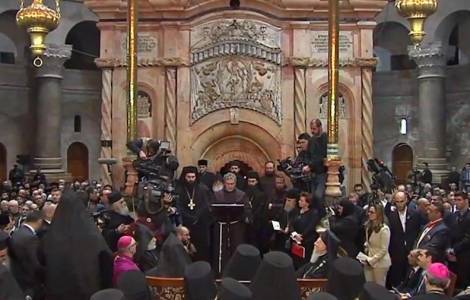
terrasanta.net
Jerusalem (Agenzia Fides) - The second phase of the restoration and preservation works of the Basilica of the Holy Sepulcher enters the preparatory phase, and the pivotal role that will be entrusted to qualified Italian bodies and institutions in the delicate work of structural requalification of the place of worship dear to all the Christians of the world has been confirmed. On Tuesday 8 October, at the Custody of the Holy Land, a framework agreement was signed between the Custody of the Holy Land and “La VenariaReale” Foundation Centre for the Preservation and Restoration of the Cultural heritage of Turin in collaboration with the Department of Classical Studies of “La Sapienza” University of Rome.
The two academic institutions will have the task of carrying out an in-depth study of the current state of the site, including from the historical-archaeological point of view and preparing the final project of the restoration work necessary.
The signature is part of the agreement signed by the three major Christian communities, custodians of the Holy Sepulcher and responsible of the "Status Quo" in the holy place: the Greek Orthodox Patriarchate of Jerusalem, the Armenian Apostolic Patriarchate of Jerusalem and the Custody of the Holy Land itself. The three ecclesial realities will also take charge of raising funds necessary to finance the demanding restoration work.
In March 2017, as reported by Agenzia Fides (see Fides, 23/3/2017), the alarm on the risk of a possible collapse of the Basilica of the Holy Sepulcher was launched by the same team of archaeologists and experts who at the time had successfully completed the restoration of the Edicule, (a small structure that within the Church of the Holy Sepulchre, encloses the remains of a cave that has been venerated since at least the fourth century A.D. as the tomb of Jesus Christ). The entire complex of the Holy Sepulcher – had declared Greek archaeologist Antonia Moropoulou, professor at the National Technical University of Athens (NTUA) and chief scientific supervisor of the restoration project, is apparently threatened by "a significant structural failure". And if this were to happen - added the Greek archaeologist "the failure will not be a slow process, but catastrophic".
The alarming hypotheses had emerged during the studies and surveys conducted on the Holy Sepulcher by the team of experts in charge of the restoration of the Edicule. The research carried out by that team, and reported by National Geographic, had revealed that much of the 19th-century shrine and its surrounding rotunda, appear to be built largely on an unstable foundation of crumbled remnants of earlier structures and is honeycombed with extensive tunnels and channels.
The shrine built by Constantine, built on the remains of a previous Roman temple around the one that was worshiped as the tomb of Jesus, had been partially destroyed by the Persian invaders in the 7th century, and then by the Fatimids in 1009. The church was rebuilt in the mid-11th century. The technical details of the dossier, collected in recent years thanks to the use of georadar and robotic cameras, have highlighted an alarming situation regarding the stability of the holy place, visited every year by millions of pilgrims and tourists: several of the 22-ton pillars that hold up the dome of the rotunda rest on more than four feet of unconsolidated rubble. (GV) (Agenzia Fides, 9/10/2019)